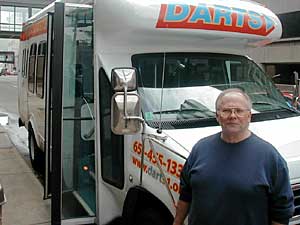|
Audio
Photos
Resources
Your Voice
|
Ride-sharing catches on in Dakota County
September 11, 2003
 |
| DARTS driver Tom Crider makes his rounds on a recent day in St. Paul. (MPR Photo/Dan Olson) |
Dakota County, Minn. — The transportation wonks are at their wit's end. We've mostly rejected every transportation option except riding alone in our own vehicle. In the Twin Cities, the Metropolitan Council reports, more drivers than ever are making more trips alone. The collective result is 279 million miles -- the equivalent of three trips to the sun. That's the total mileage racked up by Twin Cities vehicle drivers every week.
Pat Woog, on the other hand, is helping reduce the number of cars on the road by sharing a ride on DARTS with other people. On a recent day, he was joined on the ride by Don Hodges and his wife.
 | |||
"They pick you up at the door and bring you home. It's great," Woog says.
DARTS, the Dakota Area Resources and Transportation for Seniors, is a fleet of small buses. Woog and most other DARTS riders are older or disabled people headed to and from medical appointments.
There are dozens of similar van and bus services around Minnesota. Riders call, make an appointment, and the van driver picks them up at their door. The problem is, many of the shared ride van services require a day's notice for a trip. DARTS hopes to trim that waiting time to as little as one hour.
Mark Hoisser, DARTS' executive vice president, says the Dakota County ride-on-demand service uses a global postioning system. The GPS tells dispatchers where the vehicles are, and helps them map an efficient route to pick up the next passenger. This helps them tailor routes for a group of riders. Hoisser says for longer trips, the new technology helps them connect with other suburban carriers.
 | |||
"Folks can go from, let's say, Burnsville to New Hope. We can take them to the border of Dakota County, or inside the border of Ramsey County, and then get on a bus from Metro Mobility for the rest of the way," says Hoisser. "(It) saves our buses some long distance extra travel, as well as their buses some long distrance extra travel."
University of Minnesota emeritus urban planning professor Richard Bolan says a more responsive ride-on-demand service may attract people who use their car and who aren't interested in walking to a bus stop.
"They do provide door-to-door service. They do provide it at your convenience, at your schedule, not a regular schedule," Bolan says.
Most ride-on-demand services in Minnesota are heavily subsidized by tax dollars, so the riders get an amazing deal. Most pay no more than $5 for a roundtrip, while the actual cost is close seven times that amount, or $35.
Would Pat Woog and Don Hodges be willing to share a ride on a more frequent basis for all kinds of trips and pay, say, $7 one way, $14 a round trip, for the door-to-door service?
"I wouldn't mind that," Woog says.
"That's nothing. It costs that much downtown to park your car," adds Hodges.
Vans are relatively quick, clean and efficient. Still, to some there's a stigma. They're not as private as a car, and arrival time depends on how many other riders are sharing the trip.
Advocates believe shared rides in vans and other vehicles show promise. However, Richard Bolan offers a caution. He says a ride-sharing system works best in a metropolitan area where folks live a little closer together, rather than spread out in sprawling surburbs.
"These services really rely on high density development -- both high density employment centers and high density residential areas," Bolan says.
Ridership on Dakota County's DARTS ride-on-demand service is growing more than six percent a year. Most of the increase is because of the fast-growing population of older riders. DARTS officials expect the numbers will continue to grow, because the GPS technology will connect riders with a van in an hour, rather than a day.
|
News Headlines
|
Related Subjects
|
